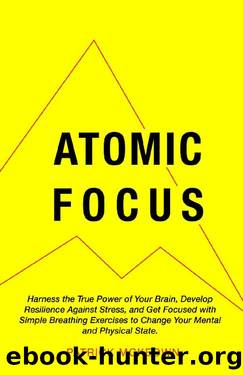Atomic Focus: Harness the True Power of Your Brain, Develop Resilience Against Stress, and Get Focused with Simple Breathing Exercises to Change Your Mental and Physical State by Patrick McKeown

Author:Patrick McKeown [McKeown, Patrick]
Language: eng
Format: epub
Publisher: OxyAT Publishing
Published: 2021-08-19T22:00:00+00:00
Recognising Your âZoneâ
The goal of COSC is resilience â the ability to weather adversity without becoming too badly affected. The idea behind the model is that stress tends to push us towards the yellow, orange and red zones, but that it is vital to return to the green zone as soon as possible. It is therefore essential to acknowledge the yellow zone, to understand that you are not functioning at your best and that your risk of becoming âinjuredâ by stress is much higher.
Itâs also important to recognize that the orange zone is not
a good place to be. You have tipped over into unmanageable stress. If you know this has happened, you may be able to rebalance your system before you need external professional support. You can do this by redefining your priorities and adapting your behavior in a way that provides sufficient recovery. At the root of this, you would address sleep and breathing patterns to access your bodyâs own recovery mechanisms.
Letâs take a quick look at each zone, so you can quickly recognize the signs of excess stress.
Green
The green zone represents a healthy balance, physically and mentally. When youâre in the green zone, you feel calm, steady, and confident. You get things done. You exercise, sleep well, eat healthily and are at peace with yourself. You can see the funny side of things and enjoy your life.
Yellow
The yellow zone represents stress. You may feel anxious, scared, angry or sad, or experience worry or irritability. You find yourself cutting corners at work because itâs harder to concentrate, and you struggle to fall asleep. You may lack energy or enthusiasm, eat too little or too much, or withdraw into yourself.
Yellow zone can be defined by distress or changes in function. But these are mild, and they resolve when the stressor is no longer present, or as you adapt to the challenge.
Orange
Orange zone is not a good place to be. It represents stress injury and might manifest as insomnia, poor control of your body, emotions or thinking, persistent feelings of guilt or shame, panic attacks or even rage. Your mental function will be compromised, and you will struggle to remember things or think clearly. You may lose confidence in your own values, and even have suicidal or homicidal thoughts.
Red
Red zone is a clinical state, requiring professional support. It may involve severe depression, anxiety and panic disorder or substance abuse/addiction. Your stress symptoms will seriously impair your ability to function and will not improve without treatment. Rather, they are likely to get worse.
You may be reluctant to acknowledge that you or a friend/colleague is suffering from red zone stress. According to a document about COSC by the US Marine Corps, many young soldiers would ârather be told they have cancer than PTSD.â A similar stigma applies in any highly competitive profession or any person who is driven and has perfectionist tendencies.
However, itâs time to rethink our attitude to stress. Some burnout researchers argue that people who suffer from burnout are not extra sensitive to stress.
Download
This site does not store any files on its server. We only index and link to content provided by other sites. Please contact the content providers to delete copyright contents if any and email us, we'll remove relevant links or contents immediately.
Spare by Prince Harry The Duke of Sussex(5078)
Machine Learning at Scale with H2O by Gregory Keys | David Whiting(4195)
Fairy Tale by Stephen King(3223)
Will by Will Smith(2795)
Hooked: A Dark, Contemporary Romance (Never After Series) by Emily McIntire(2502)
The Bullet Journal Method by Ryder Carroll(2487)
Rationality by Steven Pinker(2291)
Can't Hurt Me: Master Your Mind and Defy the Odds - Clean Edition by David Goggins(2230)
It Starts With Us (It Ends with Us #2) by Colleen Hoover(2204)
Friends, Lovers, and the Big Terrible Thing by Matthew Perry(2126)
The Becoming by Nora Roberts(2091)
Love on the Brain by Ali Hazelwood(1965)
HBR's 10 Must Reads 2022 by Harvard Business Review(1779)
The Strength In Our Scars by Bianca Sparacino(1778)
A Short History of War by Jeremy Black(1764)
Leviathan Falls (The Expanse Book 9) by James S. A. Corey(1651)
515945210 by Unknown(1602)
A Game of Thrones (The Illustrated Edition) by George R. R. Martin(1594)
Bewilderment by Richard Powers(1541)
